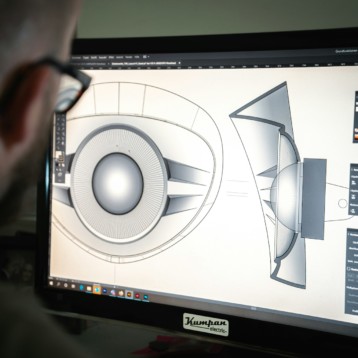The ever-growing computer industry is continuously in search of new ways to cool down microprocessors. From gigantic fans to liquid nitrogen, the computer industry and its enthusiasts continually strive to achieve better, quieter, and more reliable cooling methods. This article will examine a new concept for cooling microprocessors based on an age-old physical phenomenon called corona discharge. You can buy cheap, refurbished desktop computers and try this methods.
Methods for cooling computer components
Several methods are currently employed for cooling electronic components such as microprocessors, which could easily reach temperatures of hundred of degrees, suffering permanent damage unless cooled down properly:
|
1. Passive cooling – one of the oldest and simplest methods for cooling an object is to increase its surface area. It’s no secret that elephants use their enormous ears to cool down, and the same basic principle is applied to microprocessors, which utilize heatsinks – large metal bodies with a large number of fins that increase the surface area to allow more air to dissipate the heat from the processor. Modern heatsinks are usually made from aluminum or copper, which conduct heat well and are relatively cheap to produce. The main advantages of passive cooling are its inherent simplicity (basically a large chunk of metal), and, hence, its reliability and low cost. In addition, passive cooling produces no noise. The major disadvantage of passive cooling is its limited ability to dissipate large amounts of heat quickly. Modern heatsinks are incapable of effectively cooling high-end CPUs, not to mention high-end GPUs, without the assistance of a fan.
|
2. Active/air cooling – The most popular method for cooling modern computers is based on pushing air using fans. This method is sometimes combined with passive cooling, in which the fan pushes the hot air away from a heatsink. Active cooling is much more efficient than passive cooling alone and is also relatively cheap. But active cooling has several significant disadvantages as well; because it has moving parts, it is less reliable, breaking down frequently, thereby causing the processor to overheat and sometimes causing permanent damage. Active cooling is also relatively noisy, and although large fans rotating at slow speeds can move a lot of air without making too much noise, they will always be louder than zero decibel passive coolers.
3. Water/fluid cooling – A more complex and less popular method is water cooling. Water has a higher specific heat capacity as well as better thermal conductivity relative to that of air (meaning water can transfer heat over greater distances more efficiently than air); by pumping cold water around a processor, it’s possible to remove a large amount of heat in a short time, to be cooled down by a radiator located elsewhere inside (or outside) the computer. The main advantage of water cooling is its ability to cool down even the hottest computer components.
|
However, this comes at a price; water cooling is expensive, complex, and even dangerous in untrained hands (as water and electricity don’t mix well!). Although usually less noisy than air cooling, water cooling systems have moving parts and so have been known to suffer from reliability issues.
An entirely different approach to liquid cooling was taken by the Austin-based company nanoCoolers that a few years ago developed a liquid-metal-based cooler, with higher heat conductivity than water, containing predominantly gallium and indium. Unlike water, this compound can be pumped electromagnetically, eliminating the need for a mechanical pump. Despite its innovative nature, nanoCoolers’ liquid-metal never reached a commercial stage and the company is currently working on a different innovative technology – a thin-film solid state cooler (which uses what is known as the Peltier effect).
Another rare method of liquid cooling is liquid submersion, in which a computer is completely submerged in a liquid with very low electrical conductivity, such as oil; the computer is cooled by the exchange of heat between its parts, the cooling fluid, and the ambient air. This method is not practical for most users for obvious reasons.
|
4. Phase-change – Phase change relies on a circulating liquid refrigerant as the medium that absorbs heat from the surface to be cooled and subsequently delivers it elsewhere. Phase change is the preferred cooling method in commercial refrigerators and some air-conditioning systems. In recent years, several companies chose to employ phase change technology to cool computer components. These cooling systems are very powerful and are utilized by a small group of enthusiasts to cool down their CPU’s in order to perform extreme overclocking. Phase-change devices are generally large, complex, noisy, and extremely expensive (reaching the many hundreds of dollars).
5. Cryogenics – Even rarer than phase change-based cooling is cryogenics-based cooling, using liquid nitrogen (N2) or dry ice or carbon dioxide (CO2). These materials are used at extremely low temperatures (N2 evaporates at -196 degrees C -320.8 degrees F and dry ice evaporates at -78 degrees C – 108.4 degrees F) directly on the processor to cool it down. However, after the N2 or CO2 evaporates, it must be replaced. Damage to the processor over time from frequent temperature changes is one of the reasons cryogenics is employed only in extreme cases of overclocking and for short periods of time.
Clearly each cooling method has advantages and disadvantages. Some are expensive and noisy, others are not powerful enough, some require complex installation, and some can even damage the processor. Seeking to create a cheap, silent, highly reliable cooler capable of effectively dissipating heat from even the most demanding high-end processors, Kronos Advanced Technologies harnessed an age-old physical principal known as the corona discharge effect.
Electrostatic air propulsion and the corona discharge effect
|
|
The corona discharge cooler developed by Kronos works in the following manner: A high electric field is created at the tip of the cathode, which is placed on one side of the CPU. The high energy potential causes the oxygen and nitrogen molecules in the air to become ionized (positively charged) and create a corona (a halo of charged particles). Placing a grounded anode at the opposite end of the CPU causes the charged ions in the corona to accelerate towards the anode, colliding with neutral air molecules on the way. During these collisions, momentum is transferred from the ionized gas to the neutral air molecules, resulting in movement of gas towards the anode.
|
The advantages of the corona-based cooler are obvious: it has no moving parts thereby eliminating certain reliability issues, it can effectively cool even the most advanced and demanding processors and it operates with a near-zero noise level and with moderate energy consumption.
Kronos Technologies interview
To learn more about Kronos’ cooling technology, TFOT interviewed Professor Alexander Mamishev and PhD student Nels Jewell-Larsen from the University of Washington and Dr. Igor Krichtafovitch Chief Technology Officer at Kronos Advanced Technologies.
Q: How did you come up with the idea for cooling computer chips using the corona discharge effect and was there a Eureka! moment?
|
A: The idea of the cooling with ionic wind was not a breakthrough innovation in itself. We have always believed that we could scale the Kronos technology down in size for electronic cooling applications. The real challenge has been to determine if it is possible to generate efficient airflow due to fundamental barriers that seemed impossible to overcome in such a small package size: barriers that Kronos has been able to overcome in larger applications of it corona-based technology such as air purification devices for the health care industry and sound applications for the noise cancellation market place.
As it usually happens, the initial attempts did not work. It took more time to understand “why” and then several more years to develop a working model before we had another Eureka moment with the Kronos-based technology. Part of this latest moment was the direct result of the collaboration with our project partners – the University of Washington and Intel.
Q: Could you briefly explain the principle of corona discharge principle?
A: In it most basic form, corona discharge is converting electrical discharge into directionally dense ions causing a fluid flow (i.e., air flow without a fan).
Q:How is the corona discharge principle employed to cool the surface of a microchip in your device?
A: The “ionic wind” is generated in the vicinity of the surface to be cooled and directed to this surface, resulting in removal of the “hot surface layer.” This “layer” is like a blanket of still, hot air covering the surface, which when continually removed, reduces the temperature of the chip.
|
Q: Will the corona cooler be able to cool a processor on its own, i.e., without any additional fans or heatsinks?
A: Yes, it is possible to do all the cooling with no additional fan. So far we have proven we can generate sufficient airflow to cool moderately hot chips with a micro-size corona-based device. It is also possible to use the technology with other thermal management technologies.
Q: Does your device discharge any heat or noise (which might contribute to the temperature of the overall system)?
A: As with other Kronos-based devices, this micro cooling device is nearly silent and generates minimal heat by itself.
Q: What voltage did you use to create the charged ions?
A: Again, the operation voltage is dependent on both design and application; however, current prototypes are on the order of one kilovolt (1 kV to 8 kV).
Q: Approximately how much power will the corona-based cooler consume?
A: The power consumption of this technology varies depending on design and specific application. That said, currently we have small prototypes that are designed to cool areas approximately 1 cm2 that consume approximately 0.1 W.
Q: How much heat will the corona cooler be able to dissipate? Will it be possible to perform overclocking using the corona cooler?
|
A: We are currently targeting cooling applications in the mobile and ultra mobile sector, since they have very demanding space, power, and acoustic requirements that most conventional cooling technologies cannot adequately meet. Also, this market segment is the fastest growing and likely will be for coming years. That said, there is no reason this technology could not be used in a thermal solution for a desktop or server platform with larger TDP (Thermal Design Power/Point) requirements. As far as overclocking… I have not done the calculations, but it seems possible.
Q: Potentially how small will the corona-based cooler be?
A: Current prototypes have an active region of several cubic millimeters, and we are working to reduce that. However, the size of the device is going to be related to the heat dissipation requirements and size of the heat source. In some applications it is possible that the size of the device would have a similar footprint of the chip to be cooled and a height of only several millimeters.
Q: What are the current obstacles facing the commercialization of the corona CPU cooler?
A: Our current focus is on the optimization of this technology around a specific application and the packaging structure, maximizing device longevity, identifying ideal materials and fabrication process for both device performance and large-scale fabrication, and of course continued funding to conduct research in this direction.
Q: Where does your work stand at this point – do you have a working prototype? Do you require funding? A: Yes, we have several working prototypes that are being used to demonstrate a “proof of concept”.
Current limited funding and resources are being provided by WTC (Washington Technology Center), Kronos Air Technologies, and Intel. More funding is going to be needed to speed this project up.
|
Q: Given the proper funding, how soon will a commercial product based on your technology be available and at what price range?
A: We can only give an estimate. With current funding, it will likely take up to at least two years to get to the first commercial product. Price is difficult to estimate since it could be embedded at many different levels of the thermal solution, but our goal is to make it competitive with other cooling solutions of similar performance.




















